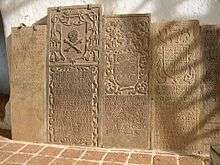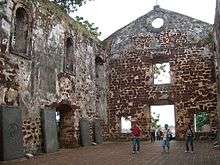St. Paul's Church, Malacca
| St. Paul's Church | |
|---|---|
|
| |
| Basic information | |
| Location | Malacca City, Malacca, Malaysia |
| Affiliation | Christianity (originally Roman Catholic, later Dutch Reformed, now a museum) |
| Year consecrated | 1521 |
| Ecclesiastical or organizational status | in ruins |
| Architectural description | |
| Architectural type | Church |


St. Paul's Church is a historic church building in Malacca, Malaysia that was originally built in 1521, making it the oldest church building in Malaysia and Southeast Asia. It is located at the summit of St. Paul's Hill and is today part of the Malacca Museum Complex comprising the A Famosa ruins, the Stadthuys and other historical buildings.
History
The original structure was a simple chapel built in 1521 dedicated to the Virgin Mary and known as the Nossa Senhora da Annunciada (Our Lady of Grace) or the Nossa Senhora da Annunciada (Our Lady of the Hill). The chapel was built by a Portuguese fidalgo or nobleman, Duarte Coelho, as an act of gratitude following his escape from a storm in the South China Sea.[1]
The chapel was deeded to the Society of Jesus in 1548 by the Bishop of Goa, João Afonso de Albuquerque, with the title deeds received by St. Francis Xavier. The chapel was then further enlarged in 1556 with the addition of a second floor, and a belfry tower was added in 1590. The chapel was then renamed the Igreja de Madre de Deus (Church of the Mother of God).
A burial vault was opened in 1592 and many people of distinction were buried there, including Pedro Martins, the second Bishop of Funay, Japan.[2]
Association with St. Francis Xavier
In 1548, St. Francis Xavier with the help of fellow Jesuits, Fr. Francisco Peres and Brother Roque de Oliveira, established a school in the premises of the chapel known as St. Paul's College. This was perhaps the first school in the modern sense to be established on the Malay peninsula.[3]
Xavier used the church as his base for his missionary journeys to China and Japan. In one of those journeys, Xavier fell sick and eventually died in Shangchuan Island, China in 1552.
In 1553, the body of Xavier was disinterred from Shangchuan Island and temporarily buried at the church before it was finally shipped to Goa. An open grave in the church still exists today marking the place of Xavier's burial.
Reconsecration and abandonment
With the conquest of Malacca by the Dutch in 1641, the church was reconsecrated for Dutch Reformed use as St. Paul's Church also known as the Bovernkerk or High Church. The church remained in use as the main church of the Dutch community until the new Bovenkerk (better known today as Christ Church Melaka) was completed in 1753.[2]
The old church was then subsequently deconsecrated and the structure modified and strengthened as part of the fortifications of Malacca. The nave of the church was then used as a churchyard.
When the British occupied Malacca in 1824, the church was used as a powder magazine and was allowed to deteriorate further.
Excavations and later additions
Efforts to preserve records of monuments from the past such as the tombstones found in St. Paul's Church were photographed by the Resident Councillor of Malacca, Robert Norman Bland and published in his 1905 work, Historical Tombstones of Malacca.[4]
In 1924, the old Portuguese burial vault in the chancel of the church was partially uncovered. Further excavation was done in 1930 by the president of the newly formed Malacca Historical Society, Major C. E. Bone. It was in this period that the tombstones that were scattered around in the vicinity of the church were affixed to the walls.[2]
In 1952, a statue of St. Francis Xavier was erected in front of the ruins of the church in commemoration of the 400th anniversary of his sojourn in Malacca. A day after the statue was consecrated, a large casuarina tree fell on it, breaking off its right arm.[5] Incidentally, the right forearm of Xavier was detached in 1614 as a relic.[6]
See also
| Wikimedia Commons has media related to St Paul Church, Melaka. |
References
- ↑ Tye, Timothy. "About Nossa Senhora da Annunciada". EarthDocumentary: World Budget Travel Guides. Retrieved 4 February 2011.
- 1 2 3 "The ruins of St. Paul's Church". The Historical City Of Malacca. Maleisie.be. Retrieved 4 February 2011.
- ↑ "The first school in Malaysia". The Historical City Of Malacca. Maleisie.be. Retrieved 4 February 2011.
- ↑ Nunn, Bernard. "Some Account of Our Governors and Civil Service." One Hundred Years of Singapore, Being Some Account of the Capital of the Straits Settlements from Its Foundation by Sir Stamford Raffles on 6 February 1819 to 6 February 1919. Ed. Walter Makepeace, Gilbert E. Brroke, and Ronald St. John Braddell. Vol. I (1). London: John Murray, 1911. [140] 69-148. Print.
- ↑ Tye, Timothy. "About The Statue of St Francis Xavier". EarthDocumentary: World Budget Travel Guides. Retrieved 4 February 2011.
- ↑ "Cappella di san Francesco Saverio". Chiesa del Gesu di Roma. Retrieved 4 February 2011.
External links
- De Witt, Dennis (2013). Historical Tombstones and Graves at St Paul's Hill Malacca. Malaysia: Nutmeg Publishing. ISBN 978-983-43519-4-6.
Coordinates: 2°11′34″N 102°14′56″E / 2.1928°N 102.2490°E